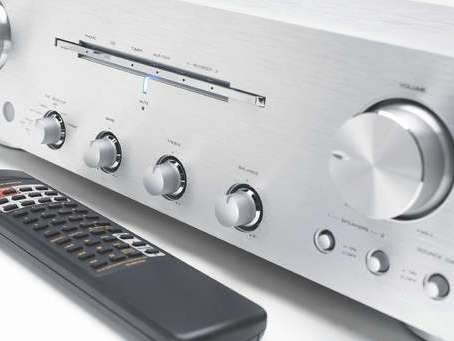TechRadar Verdict
A self-effacing amp, which may not leap out in quick-fire demos but serves the music well, with fine bass, sweet treble and unforced detail
Pros
- +
An understated performance that puts the music first
Cons
- -
Doesn't quite deliver the value on the price tag
Why you can trust TechRadar
With the basic PM7001 (£350) firmly established as one of the key amps to beat below £500, the KI version has quite some reputation to live up to. As usual with Marantz's 'Ken Ishiwata Signature' range, the basis is the same set of circuits in the same case but with individual components changed or modified in some way to achieve higher (one hopes!) performance.
From the front of the unit, there's little enough to give away the upgrades, but the case itself has benefitted from tweaks; a glance at the rear reveals copper plating on the chassis and gold on the connectors, where the basic model is plain. The copper is intended to lower the surface resistance of the case and hence improve interference rejection, which it probably achieves.
It certainly looks funky and it's only a shame it's not normally visible. That's unlike the smart front panel, which we find one of the most attractive of the bunch, its blue indicators achieving just the right brightness without glare.
Inside the amp, the mains transformer is a large toroidal type with a screen around it, which feeds unusually well specified smoothing capacitors via ultra-fast rectifier diodes. This all adds up to a pretty high-end power supply and bodes well for sonic performance. The main circuit elements, however, are standard PM7001 fare, with electronic input switching, good but not outstanding op-amps and a good quality motorised volume control.
It seems that if you like masses of detail, perfectly etched and precise, this may not be your automatic choice from the bunch. On the other hand, it does have a great deal to offer in terms of presenting a homogeneous - but not homogenised! - musical ensemble with grace and poise.
It also has some very desirable tonal qualities. Its bass was consistently praised for extension, control and tunefulness and as such appears to be trespassing on what is normally considered the territory of seriously upmarket kit. Treble is also sweetly extended with only a trace of constriction in the most demanding situations, such as when reproducing a triangle or a high violin solo.
Sounding out
Stereo imaging is not as strong, one listener suggesting explicitly that it lagged the group average while the others simply didn't mention it either way. And the area that divided our panel most was dynamics, which varied in perception from effortlessly broad to slightly constricted.
We listened carefully to dynamic behaviour after the panel had left and concluded that, while there is certainly a good range on offer, it is presented in a rather understated way, which we rather liked. It may not impress on a quick audition, though.
'Understated' is a pretty good a summary of this amplifier's overall performance, and perhaps it's not everyone's cup of tea. However, you may well agree with the conclusion of one of our listeners that this is a particularly beguiling amp, which specifically does not sound 'hi-fi' but puts the music first and - as he guessed and we confirmed - endears itself in the long run.
LAB REPORT
The 70W power rating is conservative, though the difference between rated and measured power only amounts to about 1dB. Frequency response and output impedance are likewise broadly par for the course these days. This amp's strength from a technical viewpoint is its distortion, which when expressed as a simple figure is rather good in several ways. For a start, it decreases most obligingly when output level drops, pretty much vanishing into noise below a few watts output. What's more, it contains almost entirely low harmonics at low frequencies, generally considered to be less audible in the output.
At higher frequencies the level of distortion rises a little, though not too alarmingly, and higher harmonics also appear together with a little phase modulation. None of this is at a very worrying level and basically this amp is very well behaved. Taking operating and standby power consumption into account, it's the greenest of the group too!
Tech.co.uk was the former name of TechRadar.com. Its staff were at the forefront of the digital publishing revolution, and spearheaded the move to bring consumer technology journalism to its natural home – online. Many of the current TechRadar staff started life a Tech.co.uk staff writer, covering everything from the emerging smartphone market to the evolving market of personal computers. Think of it as the building blocks of the TechRadar you love today.

